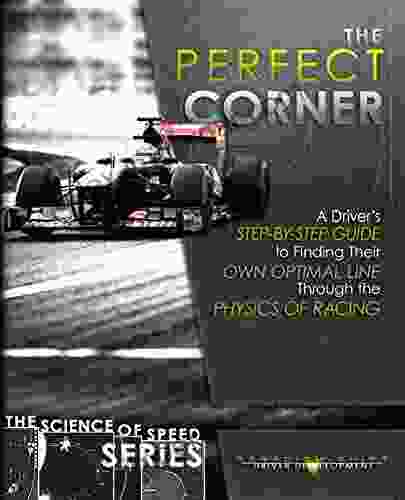Step by Step Guide to Finding Your Own Optimal Line Through The Physics

By John Doe
If you're serious about improving your driving skills, then you need to understand the physics of racing. This book will teach you everything you need to know about finding your own optimal line through the physics, no matter what your driving experience or skill level.
4.3 out of 5
| Language | : | English |
| File size | : | 12476 KB |
| Text-to-Speech | : | Enabled |
| Enhanced typesetting | : | Enabled |
| Word Wise | : | Enabled |
| Lending | : | Enabled |
| Screen Reader | : | Supported |
| Print length | : | 108 pages |
In this book, you'll learn about:
- The forces that act on a car
- How to use these forces to your advantage
- The importance of car setup
- How to find your own optimal line
With this knowledge, you'll be able to drive faster, safer, and more efficiently. You'll also be able to improve your car's performance and lap times.
This book is a must-read for any driver who wants to improve their skills. It's also a great resource for racing drivers, track day enthusiasts, and anyone who wants to learn more about the physics of racing.
Table of Contents
- The Forces that Act on a Car
- How to Use These Forces to Your Advantage
- The Importance of Car Setup
- How to Find Your Own Optimal Line
Driving is a complex skill that requires a combination of physical and mental abilities. In Free Download to drive safely and efficiently, you need to understand the physics of racing.
This book will teach you everything you need to know about finding your own optimal line through the physics. This line is the path that allows you to drive the fastest and safest around a corner.
By understanding the physics of racing, you'll be able to improve your driving skills and lap times. You'll also be able to reduce your risk of accidents.
The Forces that Act on a Car
There are four main forces that act on a car: gravity, friction, drag, and lift.
- Gravity is the force that pulls the car down towards the ground.
- Friction is the force that opposes the movement of the car. It is caused by the contact between the tires and the road.
- Drag is the force that opposes the movement of the car through the air. It is caused by the shape of the car and the speed of the car.
- Lift is the force that opposes gravity and lifts the car up. It is caused by the shape of the car and the speed of the car.
The combination of these four forces determines the speed and direction of the car.
How to Use These Forces to Your Advantage
In Free Download to drive faster and more efficiently, you need to understand how to use these forces to your advantage.
Here are some tips:
- Use gravity to your advantage. Gravity pulls the car down towards the ground, which helps to keep the tires in contact with the road. This gives you more grip and allows you to drive faster.
- Reduce friction. Friction slows the car down. You can reduce friction by using tires with a low coefficient of friction and by keeping the car in good condition.
- Reduce drag. Drag slows the car down. You can reduce drag by streamlining the car and by driving at a slower speed.
- Use lift to your advantage. Lift can help you to accelerate and to brake. You can use lift by driving over a hill or by using a spoiler.
The Importance of Car Setup
Car setup is essential for finding your own optimal line through the physics. The right setup will help you to get the most out of your car and to improve your lap times.
There are many different car setup options available, and the best setup for you will depend on your car, your driving style, and the track conditions.
Some of the most important car setup options include:
- Tire pressure. Tire pressure affects the grip and handling of the car.
- Suspension. The suspension affects the way the car handles bumps and corners.
- Aerodynamics. Aerodynamics affects the drag and lift of the car.
- Weight distribution. Weight distribution affects the balance and handling of the car.
It's important to experiment with different car setup options to find the best setup for you.
How to Find Your Own Optimal Line
The optimal line is the path that allows you to drive the fastest and safest around a corner.
To find your own optimal line, you need to consider the following factors:
- The radius of the corner. The radius of the corner determines the speed at which you can enter and exit the corner.
- The grip level of the track. The grip level of the track affects the amount of speed you can carry through the corner.
- The car's setup. The car's setup affects the handling of the car and the amount of speed you can carry through the corner.
Once you've considered these factors, you can start to experiment with different lines to find the optimal line for you.
Here are some tips for finding your own optimal line:
- Start by driving slowly. This will give you time to learn the corner and to find the best line.
- Experiment with different lines. Try driving different lines through the corner to find the line that gives you the best grip and speed.
- Use your mirrors. Your mirrors can help you to see where other cars are and to avoid accidents.
By understanding the physics of racing, you can improve your driving skills and lap times. You can also reduce your risk of accidents.
This book has taught you everything you need to know about finding your own optimal line through the physics. Now it's up to you to put this knowledge into practice and to become a better driver.
4.3 out of 5
| Language | : | English |
| File size | : | 12476 KB |
| Text-to-Speech | : | Enabled |
| Enhanced typesetting | : | Enabled |
| Word Wise | : | Enabled |
| Lending | : | Enabled |
| Screen Reader | : | Supported |
| Print length | : | 108 pages |
Do you want to contribute by writing guest posts on this blog?
Please contact us and send us a resume of previous articles that you have written.
 Book
Book Novel
Novel Page
Page Chapter
Chapter Text
Text Story
Story Genre
Genre Reader
Reader Library
Library Paperback
Paperback E-book
E-book Magazine
Magazine Newspaper
Newspaper Paragraph
Paragraph Sentence
Sentence Bookmark
Bookmark Shelf
Shelf Glossary
Glossary Bibliography
Bibliography Foreword
Foreword Preface
Preface Synopsis
Synopsis Annotation
Annotation Footnote
Footnote Manuscript
Manuscript Scroll
Scroll Codex
Codex Tome
Tome Bestseller
Bestseller Classics
Classics Library card
Library card Narrative
Narrative Biography
Biography Autobiography
Autobiography Memoir
Memoir Reference
Reference Encyclopedia
Encyclopedia Brandon D Crowe
Brandon D Crowe Brooke Giannetti
Brooke Giannetti Brenna Craven Dumas
Brenna Craven Dumas Brian Allison
Brian Allison Gavin Mcinnes
Gavin Mcinnes Robert N Trigiano
Robert N Trigiano Bodhi
Bodhi Susan Kapuscinski Gaylord
Susan Kapuscinski Gaylord Brian Harvey
Brian Harvey Vadim Issakov
Vadim Issakov Laura Childs
Laura Childs Colleen Mullaney
Colleen Mullaney Kim Han
Kim Han Donovan A Shilling
Donovan A Shilling Vitaly Yu Topolov
Vitaly Yu Topolov Paul Bergman
Paul Bergman Tory Johnson
Tory Johnson Sarah Crawford Isto
Sarah Crawford Isto Di Lebowitz
Di Lebowitz Jeffrey G Snodgrass
Jeffrey G Snodgrass
Light bulbAdvertise smarter! Our strategic ad space ensures maximum exposure. Reserve your spot today!

 Wayne CarterThe Unknown Battle: Defending the Demilitarized Zone against North Korea's...
Wayne CarterThe Unknown Battle: Defending the Demilitarized Zone against North Korea's...
 Emilio CoxUnlock the Secrets of Backyard Sustainability: Build a Tray Expandable Fodder...
Emilio CoxUnlock the Secrets of Backyard Sustainability: Build a Tray Expandable Fodder... Jake CarterFollow ·10.9k
Jake CarterFollow ·10.9k Adam HayesFollow ·14.6k
Adam HayesFollow ·14.6k Edison MitchellFollow ·17.3k
Edison MitchellFollow ·17.3k Drew BellFollow ·19.7k
Drew BellFollow ·19.7k Trevor BellFollow ·5.4k
Trevor BellFollow ·5.4k Mason PowellFollow ·14k
Mason PowellFollow ·14k Brian BellFollow ·5.2k
Brian BellFollow ·5.2k Scott ParkerFollow ·14.5k
Scott ParkerFollow ·14.5k

 Gary Cox
Gary CoxUnlocking Meaning and Purpose in Life: An Exploration of...
In an increasingly...

 Eric Hayes
Eric HayesMemoirs of the Early Pioneer Settlers of Ohio Illustrated
A Window into the Lives of Courageous...

 J.R.R. Tolkien
J.R.R. TolkienThe Montgomerys and Their Descendants: A Saga of Courage,...
Prepare to be...

 Avery Simmons
Avery SimmonsThe Rifle Musket: The Dawn of Modern Infantry Warfare
: The rifle musket, a revolutionary...

 Jesse Bell
Jesse BellUnlock the Power of Excel with VBA and Macros: A...
Microsoft Excel is a powerful spreadsheet...
4.3 out of 5
| Language | : | English |
| File size | : | 12476 KB |
| Text-to-Speech | : | Enabled |
| Enhanced typesetting | : | Enabled |
| Word Wise | : | Enabled |
| Lending | : | Enabled |
| Screen Reader | : | Supported |
| Print length | : | 108 pages |










